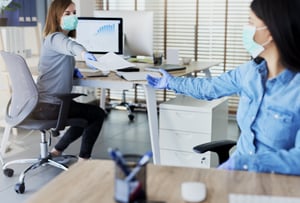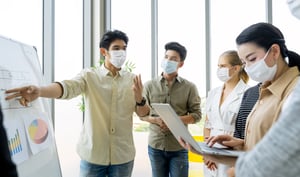Executive Summary:
- Employees will feel, and be, more productive when they perceive their workplace is safe.
- There is an opportunity for collaboration improvements in a healthy workplace.
- Employees' creativity and morale will improve due to having a readiness plan.
For companies, the prospect of reopening in a post-pandemic world leads to inevitable changes in the workplace environment, the way people collaborate, commute, interact, and more. As employees return to work, all organizations will need to reshape their policies, shift schedules, rotations, and many other aspects and procedures in order to minimize their risk of exposure to the virus. This is essential for keeping your workplace healthy and productive.
Irrespective of the size of your workplace, you can take simple yet effective measures to keep your employees safe both during and following a pandemic. And the best thing about these measures is that they are practical, low-cost, and relatively easy to implement.
If management shows that it is strongly committed to keeping employees safe, this will not only translate into less sick leave being taken but will also improve productivity, work culture, and overall employee well-being. Net, you will see productivity gains. So, let’s start by taking a closer look at the benefits of having a good reopening plan in place.
Employees Who Feel Safe at Work Are More Productive
Research shows that increased levels of anxiety and stress in the workplace take a toll on work performance and job satisfaction. The key research findings from an employee survey indicate that anxiety affects the following aspects of working life:
- Job performance (56%)
- Relationships with colleagues (51%)
- Communication with managers (50%)
- Quality of work (43%)
By implementing protective measures in the post-pandemic period, you are relieving your employees of the mental burden of uncertainty. As a result, stress and anxiety levels will drop, while productivity will spike.
Protective Measures Strengthen Your Employer Branding

Your conduct during challenging times and the way you treat your employees will pay off years after a pandemic or crisis. If you demonstrate empathy and show that you care about your staff’s health and well-being during challenging times, your brand will thrive, making your company more attractive to top talent.
Moreover, providing your staff with peace of mind and support in stressful times has a more significant impact on your employees' dedication than any loyalty program you could implement. The measures taken now will have a long-lasting impact on work culture, employee morale, and commitment.
A Clear Action Plan Improves Teamwork
Keeping team spirit high is key to boosting work productivity when your organization reopens. Social distancing, lack of communication, and the general sense of uncertainty can have a negative impact on teamwork, resulting in more silos and turning employees into solo runners.
On the other hand, the pandemic equally presents an opportunity to build a stronger team connection by actively involving your employees in creating an actionable health protection plan. The collective effort will enhance their sense of ownership and shared responsibility while improving team spirit and collaboration.
Psychological Safety Impacts Employee Morale
Perceived safety in the workplace has a considerable effect on the psychological well-being of your staff. An unpleasant employee experience can affect psychological safety by up to 35%. In uncertain times, employee misconduct may increase by as much as 33%.
To prevent this kind of disruption to employees' morale and unethical behavior, the top management needs to communicate quickly and confidently about the protective measures that have been implemented for the post-pandemic period. Furthermore, you should encourage your employees to report any instances of misconduct and noncompliance with these measures.
Creating a Company Readiness Plan

There are many ways in which companies can prepare themselves to react to challenging events and periods, such as a pandemic. One of the first steps is to develop and document an actionable plan of measures and policies to keep your staff safe from the virus. Creating and executing an actionable protection plan will reduce your employees' concern about getting infected, which will ultimately boost their productivity.
To create a viable plan that works for everyone, it is necessary to involve your employees and welcome their ideas. This plan should main critical aspects on how to protect employees in a pandemic situation, while also ensuring that the business can continue to run in spite of the extraordinary and unprecedented conditions. Here are some steps that can be taken in this direction:
- Assemble a cross-functional crisis response team
- Evaluate organizational and process weaknesses
- Develop tactics to tackle these weaknesses
- Define measures that can be implemented to minimize unpreventable risks
- Create a communication plan to keep your employees in the loop
- Offer a communication platform where HR can answer employees’ questions
Keep updating the plan based on experiences, ideas, and developments; this will make it stronger and more effective.
Key Measures to Keep Your Employees Safe and Motivated
Since any infection is passed from person to person, the risk of your employees contracting a disease can be reduced considerably if you minimize direct contact between your staff and with people from outside. Here are some practical ways to reduce your employees’ exposure to disease without compromising collaboration and their mental strength:
- Employees who don’t feel well should stay home. Ask your workers not to come to the office if they or any of their family members are not feeling well or are experiencing any flu symptoms, such as cough, headache, or high temperature.
- Provide your employees with ample space. When returning to the office environment after working from home, your employees will expect modern offices that adhere to higher safety standards. Rearrange the office setting to ensure that your staff has at least a 6-feet space between workstations.
- Create one-way pathways. Since it is impossible to keep a safe distance apart on staircases and in most corridors, it is necessary to reduce human-to-human contact by creating one-way routes. Even though it might increase the time needed to get to the workstation, this measure will significantly reduce the number of unnecessary face-to-face encounters between employees on their way there.
- Keep the reception area safe. Most employees and visitors alike will enter the premises through the lobby which means people who work nearby are at higher risk of getting infected. Protect them by minimizing human contact when visitors arrive by implementing a touchless visitor management system.
- Keep on-site dining options closed. Naturally, after a prolonged period of isolation, your employees will want to socialize with their colleagues during their lunch break. To prevent unnecessary gatherings of people, it is advisable to keep the on-site dining facility closed. Instead, provide take-away food, water, and beverages for all employees. The meals can be delivered to each desk to avoid the formation of crowds at lunchtime.
- Limit physical presence. Employees who can do their work remotely should be allowed to do so either regularly or periodically. This will considerably reduce the number of staff members present in the workplace and provide those who are in the office with sufficient space to keep their distance from one another.
- Improve communication. Keep your employees in the loop about the preventive measures and developments being taken and made within your company. This way, you will be able to control the information flow and ensure that it is accurate, while also cutting the potential for speculation and fake news. However, do not foster panic or anxiety by publishing updates every day. Create a living document that can simply be updated based on the relevant developments.
- Arrange frequent cleaning cycles. In response to the coronavirus pandemic, the Centers for Disease Control and Prevention (CDC) have issued detailed recommendations on how workplaces should be cleaned. According to these guidelines, regular disinfection and cleaning of surfaces, doorknobs, and equipment that many people use frequently (e.g., scanners, copiers) will significantly minimize the risk of virus transmission in the workplace.
- Initiate brainstorming. Ask your employees to share their ideas on how to better protect themselves without impairing collaboration and teamwork. Since they are very familiar with their work environment and processes, they are sure to have many proposals and practical tips on how to keep their workplace safe.
- Enable a safer commute. Explore ways you can help your team members avoid commuting by public transit.
- Cleaning personnel is at higher infection risk. Minimize their exposure to viruses by providing them with personal protective equipment (PPE) such as face masks, gloves, and protective clothing.
- Quarantine objects are brought in from outside. Letters, parcels, and any items delivered from outside the workplace could be contaminated with the virus. They should therefore be placed in designated isolation containers for at least 48 hours before employees can open them.
- Urge employees to wear face masks. Encourage workers to wear masks at work, as this is one of the most effective and inexpensive measures to mitigate the spread of the disease.
- Help your staff to maintain personal hygiene by placing hand sanitizers and wipes at different places around the workplace and workstations.
- Eliminate the need to share items. Supply your employees with sufficient equipment, stationery, and other materials from computers to safety gloves and goggles to eliminate the need to borrow or share such items.
- Facilitate safe business travel. Re-think your organization’s approach to employee travel. Define specific cases in which an employee needs to travel versus examples where videoconferencing will be an adequate replacement. If business trips cannot be avoided, provide your employees with guidance on how to stay safe whilst traveling and sufficient protective items such as face masks and sanitizers.
- Be empathetic and supportive. While focusing on the physical health of your employees, it is easy to overlook their mental well-being. People naturally react to stress in different ways, meaning that some team members might become hyper-effective while others' performance will drop. Therefore, understanding and addressing the unspoken challenges faced by your workers is the first step towards providing a solution that will boost their sense of safety while also enhancing efficiency.
 Supporting Collaboration and Productivity
Supporting Collaboration and Productivity
While implementing all the aforementioned measures to keep your employees safe, it is vital to make sure that they have the tools and technologies they need to work efficiently, collaborate and be productive in the post-crisis situation that will be the new, and hopefully improved, normal.
Since people have different working styles and process preferences, and so much will be new, there is a risk of an increase in conflict between team members. For example, some people might prefer email while others may be much quicker to respond to messages via Slack. While this could lead to initial confusion, team leaders can avoid this issue by offering training. Establish ground rules for communicating and collaborating remotely to ensure that everyone is on the same page, thus facilitating the process for all employees.
Conclusion – There Is a Path to a “New Normal” That Is More Productive Than Ever
Times of crisis bring about some of the most memorable situations that will, ultimately, create a lasting impression of your organization. As a leader, you have the power to influence whether this impression will be a good one. Capitalize on this opportunity to demonstrate your ability to lead your employees in times of crisis by putting their needs and health above all else.
Keeping your employees safe from a pandemic is essential to fostering their loyalty, strengthening their work ethic, and maintaining productivity. Consequently, it is vital to develop an action plan to be followed both during and after a pandemic. Any organization, whether big or small, can implement practical yet low-cost measures that will drastically reduce the risk of employees contracting a disease.
By communicating clearly about the health protection measures, collaborating, and meeting guidelines, you will successfully reduce uncertainty and anxiety while redirecting your employees’ mental energy towards efficient working and cooperation habits and practices. The post-pandemic plan that your company implements now is likely to serve as a point of reference and long-term perceptions about your firm.